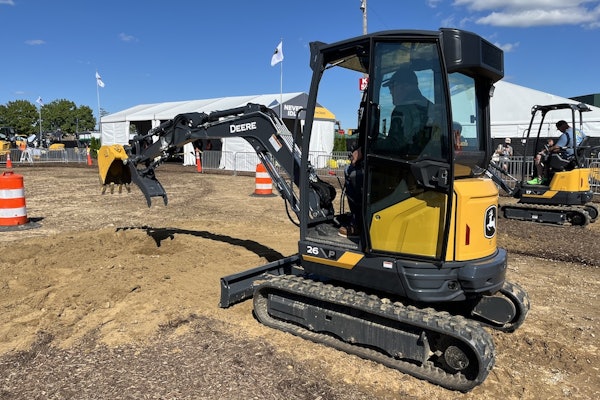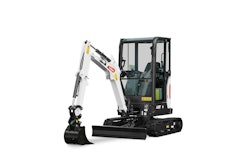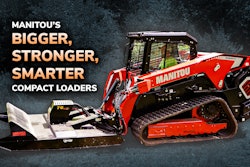Dozers in the 75-net horsepower or less range with operating weights of less than 20,000 pounds represent 15 percent of the overall dozer market and make up the second most popular size class in the industry. “These dozers are more maneuverable than larger machines,” says Dan Drescher, product marketing manager, crawlers, John Deere. “They’re suitable for finish grade work, large scale landscaping – basically all site preparation jobs.”
Shifts in power
The shift to hydrostatic drive transmissions and six-way blades has given smaller dozers the advantage needed to accomplish detailed jobs.
“Hydrostatic transmissions have made it easier to steer and control speed with one control lever or joystick. In the past, dozers had multiple levers that the operator had to actuate,” says Joel Fritts, senior project marketing engineer, track type tractors, Caterpillar. “It’s a lot less cumbersome to run a dozer now.”
Early hydrostat designs didn’t yield a dependable system. “There were a lot of problems in the ’80s, which made contractors skittish,” Fritts admits.
Now, smaller crawler hydrostatic powertrains have increased their user-friendliness in many cases, according to Bernie Winker, manager of marketing and engineer services, Dressta.
Enhanced steering modulation on the newer dozers can reduce operator fatigue, as it requires less effort. Having steering and speed control in one hand and blade controls in the other allow the operator to sit back and work comfortably.
Dozers in this category also feature hydraulically actuated braking and deceleration modes. “With dynamic braking, the machine’s not going anywhere once it’s put in neutral,” Drescher says. In other words, once oil flow has been restricted from the motors, the dozer stops completely.
For further machine control, the operator can select deceleration mode and push the decelerator pedal, slowing the engine and transmission speed or set it so only the transmission speed decreases.
Pushing it
Although dozers in this size class don’t typically perform many heavy-duty applications, they can clear trees and brush or help with land improvement tasks, such as waterways and terraces. Compact crawlers do well with light duty work and fine grading, but when you have massive loads of heavy material, you’d be better off with a non-hydrostatic drive machine, Drescher says. “Smaller dozers just don’t have the horsepower and weight to tackle extreme heavy-duty jobs,” he explains.
On the other hand, if you’re looking for a machine sturdy enough to push and pull material around a jobsite, compact dozers can get the job done quickly.
Manufacturers of compact dozers offer six-way blades – also known as variable power angle tilt or power angle tilt blades. “The more angles or positions you can put your blade in, the more shaping you’re able to do to meet job requirements,” Fritts says.
A six-way blade allows you to push and side cast material without turning the machine, proving useful when working alongside foundations. Other uses include cutting V-trenches with the tilt function, engaging a boulder and moving it out of a restricted area, pulling tree stumps and dressing a slope so it drains differently, Winker adds.
“The versatility of a VPAT blade provides functionality to perform several tasks with one machine, thus lowering operating costs and improving the operator’s profitability,” Fritts says.
When spec’ing a compact dozer, contractors should take note of the operating weight, horsepower, blade width and blade capacity. Several crawlers in this category come standard with a 97-inch blade, and according to Drescher, Deere’s low ground pressure (LGP) model can handle a blade up to 124 inches. “With this type of blade, you’re going to clear a swath of about 8 to 10 feet,” he says.
Track selection
Undercarriage selection has implications in how well jobs can be done and how long tracks can stand to be replaced. For compact dozers, Rusty Schaefer, platform marketing manager for Case Construction Equipment, says it’s best to match your undercarriage selection to the ground conditions. Many manufacturers offer long track, low ground pressure (or LGP) and wide track models.
LGP dozers tend to be wider than long track dozers and they allow even wider shoes to be fitted to them. Shoe widths available for compact dozers range from 15 inches up to 25 inches. “You can always go to a smaller shoe, but you can’t go to a bigger one,” Winker explains. “That’s why it’s safer to get the biggest track size available at the time and then downsize if necessary later on.”
As a general rule of thumb, the narrower the track shoe, the harder the ground needs to be. Narrow shoes do well in rocky conditions, while wider shoes perform better in softer areas. Therefore, Schaefer says it’s important to make sure you have enough width to meet your flotation requirement. By broadening the dozer’s weight across a larger area, wider tracks disturb the ground less. They also possess the ability to trudge through swampy or muddy areas better than narrow shoes, since they aren’t digging into the ground as much. But be careful: If you run over boulders or rocks with a wider track shoe you will wear out your undercarriage faster, Winker cautions.
For extra durability and to establish a strong base for fine grading, Komatsu offers track frames welded to the mainframe on its D31PX-21 KomStat II, instead of what it says is the less durable option of bolting the track frames to the mainframe. “Pay attention to the quality of manufacture,” says Bruce Boebel, product marketing manager, crawler dozers, Komatsu. You want to invest in a machine that will last, thereby reducing long term investment, such as repair costs.
Case offers its extended life track (or CELT) – an additional floating bushing on the chain length of the track that evens out wear – to extend the life of dozer undercarriages plowing through abrasive or sandy soils. “The CELT reduces operating costs per hour, making the contractor more profitable,” Schaefer says. This option comes on all Case dozers.
Additionally, operators should pay close attention to track tension and set up jobs calling for less operation in reverse, Drescher warns. “This lessens the chances of accelerated wear,” he says. Cleaning debris out of the undercarriage will also help prolong track life.
Grade control helps eliminate inconsistencies
Along with enhanced transmissions and maneuverability, grade control global positioning systems have also increased the sales and demand of small to mid-sized dozers. “Grade control GPS improves the accuracy of anybody’s work,” Drescher says. “It makes good operators even better and quicker, and if you’re a beginner, GPS turns you into a good operator faster.”
Deere’s integrated grade control option for compact dozers has plug-and-play installation – meaning the machine comes pre-wired with valves needed to communicate with a grade control system. “Having this option removes any of the installation inconsistencies that may occur if a user attempts to install the system on his own,” Drescher says.
A calibrated GCS helps get contractors off and running, and it also shows the system’s mobility by allowing users to simply remove the GCS and mount it to another machine if necessary, Drescher notes.
Added bonus: A compact dozer equipped with grade control GPS eliminates the need for a box scraper to come in later, furthering the machine’s efficiency for finish grading purposes.









